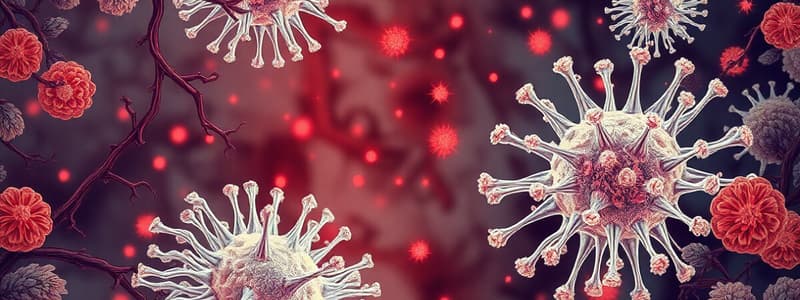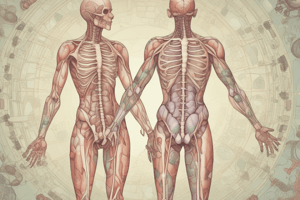Podcast
Questions and Answers
What initiates the formation of IgE upon first exposure to an antigen?
What initiates the formation of IgE upon first exposure to an antigen?
- Chemical displacement of histamine
- Formation of IgE antibodies (correct)
- Degranulation of mast cells
- Binding of histamine to mast cells
Which of the following is required for immunological release of histamine?
Which of the following is required for immunological release of histamine?
- Amines such as tubocurarine
- Histamine receptors H1 and H2
- Presence of toxins
- Energy and calcium (correct)
Which histamine receptor subtype is primarily involved in increasing cAMP levels?
Which histamine receptor subtype is primarily involved in increasing cAMP levels?
- H4
- H1
- H2 (correct)
- H3
What distinguishes chemical and mechanical release of histamine from immunological release?
What distinguishes chemical and mechanical release of histamine from immunological release?
What effect does released histamine exert via H2 receptors on mast cells?
What effect does released histamine exert via H2 receptors on mast cells?
Which of the following is NOT a distribution site for H1 receptors?
Which of the following is NOT a distribution site for H1 receptors?
What is one effect of serotonin (5-HT) on large blood vessels?
What is one effect of serotonin (5-HT) on large blood vessels?
Which type of receptor, among the histamine receptors, is associated with presynaptic locations in the CNS?
Which type of receptor, among the histamine receptors, is associated with presynaptic locations in the CNS?
In the context of serotonin's actions on platelets, how does it contribute to platelet aggregation?
In the context of serotonin's actions on platelets, how does it contribute to platelet aggregation?
What is the mechanism of action for histamine released from mast cells?
What is the mechanism of action for histamine released from mast cells?
What role does serotonin (5-HT) play in the central nervous system (CNS)?
What role does serotonin (5-HT) play in the central nervous system (CNS)?
How does serotonin affect small blood vessels?
How does serotonin affect small blood vessels?
What is one consequence of injecting serotonin (5-HT) intravenously?
What is one consequence of injecting serotonin (5-HT) intravenously?
Which receptor is primarily involved in the vasodilation effect of histamine on vascular smooth muscle?
Which receptor is primarily involved in the vasodilation effect of histamine on vascular smooth muscle?
What effect does histamine have on cardiac function?
What effect does histamine have on cardiac function?
In asthmatic patients, histamine typically causes which of the following effects?
In asthmatic patients, histamine typically causes which of the following effects?
Histamine acts on what type of cells in the gastric system to increase acid secretion?
Histamine acts on what type of cells in the gastric system to increase acid secretion?
Which effect of histamine can lead to edema in tissues?
Which effect of histamine can lead to edema in tissues?
What adverse effect can occur in the gastrointestinal tract due to histamine's action?
What adverse effect can occur in the gastrointestinal tract due to histamine's action?
What sensation does histamine cause in the epidermis?
What sensation does histamine cause in the epidermis?
Which of the following describes the mechanism of histamine's direct action on vascular smooth muscle?
Which of the following describes the mechanism of histamine's direct action on vascular smooth muscle?
What is the primary purpose of Pizotifen in migraine treatment?
What is the primary purpose of Pizotifen in migraine treatment?
Which receptor is primarily involved in the emesis process?
Which receptor is primarily involved in the emesis process?
What is the mechanism of action for SSRIs in treating depression?
What is the mechanism of action for SSRIs in treating depression?
Which of the following conditions is NOT typically treated with 5-HT3 antagonists?
Which of the following conditions is NOT typically treated with 5-HT3 antagonists?
What is a common underlying theory connecting serotonin levels to depression?
What is a common underlying theory connecting serotonin levels to depression?
What is a common side effect associated with 1st generation H1 antagonists?
What is a common side effect associated with 1st generation H1 antagonists?
Which mechanism primarily accounts for the anti-emetic effects of promethazine?
Which mechanism primarily accounts for the anti-emetic effects of promethazine?
Where is the highest concentration of serotonin (5-HT) found in the body?
Where is the highest concentration of serotonin (5-HT) found in the body?
Which 5-HT receptor subtype is primarily responsible for the inhibition of serotonin release?
Which 5-HT receptor subtype is primarily responsible for the inhibition of serotonin release?
What action does 5-HT have on the gastrointestinal tract?
What action does 5-HT have on the gastrointestinal tract?
What enzyme is primarily responsible for the degradation of serotonin (5-HT)?
What enzyme is primarily responsible for the degradation of serotonin (5-HT)?
Which of the following 1st generation antihistamines primarily promotes sedation?
Which of the following 1st generation antihistamines primarily promotes sedation?
Which receptor subtype is a ligand-gated cation channel among 5-HT receptors?
Which receptor subtype is a ligand-gated cation channel among 5-HT receptors?
What physiological effect does activation of the vomit center by 5-HT lead to?
What physiological effect does activation of the vomit center by 5-HT lead to?
Which compound is used as an anxiolytic through partial agonism at 5-HT receptors?
Which compound is used as an anxiolytic through partial agonism at 5-HT receptors?
Flashcards are hidden until you start studying
Study Notes
Histamine Release
-
Immunological Release:
- First exposure to an antigen results in the formation of IgE, which binds to mast cells.
- Second exposure triggers explosive degranulation, releasing histamine.
- This process requires calcium and energy.
- IgG and IgM can also stimulate histamine release from mast cells.
- Released histamine exerts negative feedback via H2 receptors on mast cells in the skin and blood, but not the lungs.
-
Chemical and Mechanical Release:
- Certain amines, including drugs like morphine and tubocurarine, can displace histamine from its bound form within cells.
- This process doesn't require energy and is not associated with mast cell injury or explosive degranulation.
Histamine Receptors
- There are four subtypes of histamine receptors: H1, H2, H3, and H4.
- All histamine receptors are G protein-coupled receptors (GPCRs).
- H1 receptors are primarily found in smooth muscle (vascular and bronchial), endothelial cells, the CNS, and other cell types.
- H2 receptors are mainly located in the gastric mucosa, parietal cells, cardiac muscle, smooth muscle, mast cells, the CNS, and other cell types.
- H3 receptors are found in the CNS (presynaptic) and other cell types.
- H4 receptors are found in cells of hematopoietic origin.
Histamine Actions
-
Blood Vessels:
- Histamine causes vasodilation via H1 receptors on vascular endothelium, leading to nitric oxide (NO) release.
- It also directly dilates vascular smooth muscle through H2 receptors.
- Histamine increases capillary permeability via H1 receptors on endothelial cells, causing fluid and plasma protein leakage into the extracellular space.
-
Heart:
- Histamine affects cardiac contractility and electrical activity.
- It increases heart rate and force of contraction through H2 receptors.
-
Gastrointestinal Tract:
- Histamine contracts GI smooth muscle, potentially causing abdominal cramps and diarrhea.
-
Airways:
- Histamine constricts bronchial smooth muscle primarily through H1 receptors by increasing calcium levels.
-
Skin:
- Histamine causes itchiness and local inflammatory responses.
-
Sensory Nerves:
- Histamine stimulates sensory nerve endings, contributing to itching, sneezing, and other sensory effects.
Histamine Antagonists (H1)
- First-generation antihistamines are not selective for histamine receptors and can have anti-muscarinic and anti-dopaminergic effects.
- Examples include diphenhydramine, chlorpheniramine, and promethazine.
- Side effects include dry mouth, blurred vision, urinary retention, constipation, and marked sedation.
Other Uses of H1 Antagonists
- Anti-emetic: Promethazine can be used for motion sickness, morning sickness, and vertigo.
- Sedative: First-generation antihistamines can be used as sleep aids.
H2 Receptor Antagonists
- Pharmacology and Clinical Utility:
- Primarily used to inhibit gastric acid secretion.
- Helpful for gastrointestinal reflux or ulcers.
- Examples: ranitidine and cimetidine.
Serotonin (5-HT)
-
5-HT is both a neurotransmitter and a local hormone.
-
Highest concentrations are found in the intestinal wall, blood platelets, and the central nervous system.
-
Synthesis: 5-HT is synthesized from the amino acid L-tryptophan in chromaffin cells and neurons.
-
Storage: 5-HT is stored in intracellular vesicles via vesicular transporters.
-
Uptake: Platelets and neurons utilize active transporters for 5-HT uptake.
-
Degradation: 5-HT is degraded primarily by monoamine oxidase A (MAO) followed by oxidation to 5-hydroxyindoleacetic acid (5-HIAA), which is excreted in the urine.
5-HT Receptor Classification
- There are 14 subtypes of 5-HT receptors divided into 7 classes (5-HT1-7).
- All are GPCRs except 5-HT3, which is a ligand-gated cation channel.
- Most 5-HT receptor agonists and antagonists are non-selective with respect to receptor subtypes, except for 5-HT3-selective agents.
5-HT1 Receptors
-
5-HT1A:
- Location: CNS (presynaptic and postsynaptic neurons).
- Effects: Activates presynaptic neurons to inhibit serotonin release, regulating mood, anxiety, and stress; partial agonists like buspirone are used as anxiolytics.
-
5-HT1B and 5-HT1D:
- Location: Presynaptic neurons in the CNS, smooth muscle of cranial blood vessels.
- Effects: Inhibit serotonin release and cause vasoconstriction; triptans, which are 5HT-1B/1D agonists, are used for migraine treatment.
Pharmacologic Actions of 5-HT
-
Gastrointestinal Tract Motility: 5-HT facilitates peristalsis, intestinal motility, and secretion by acting directly on smooth muscle and stimulating enteric nervous system ganglion cells.
-
Nausea and Emesis: 5-HT induces nausea and emesis through activation of brain regions that control vomiting, particularly via stimulation of the vomit center in the medulla and inputs from vagal sensory fibers in the GI tract.
-
Cardiovascular Effects:
- Blood Vessels: 5-HT's effects on blood vessels depend on vessel size, location, and 5-HT receptor subtype; it typically constricts large vessels (arteries and veins) by acting directly on vascular smooth muscle cells and dilates small vessels by releasing nitric oxide (NO) and inhibiting norepinephrine release from sympathetic nerve terminals.
- Platelets: 5-HT, stored and released by platelets after contact with injured endothelium, promotes platelet aggregation by binding to platelet 5HT2A receptors.
-
Peripheral Nervous System: 5-HT stimulates nociceptive sensory nerve endings, contributing to neurogenic inflammation.
-
Central Nervous System: 5-HT plays a role in various CNS-mediated events like migraine, stress, anxiety, mood, vomiting, and appetite. It can also induce hallucinations. Cellular effects in the CNS depend on the receptor subtype and can include post-synaptic excitation, inhibition, and pre-synaptic inhibition.
5HT Receptor Antagonists as Antiemetics
-
Nausea and Vomiting: 5-HT release in the GI tract and CNS contributes to emesis, primarily mediated through 5HT3 receptors in the vomit center and peripheral neurons in the GI tract.
-
Clinical Implications: 5HT3 antagonists are effective antiemetic drugs, such as ondansetron and tropisetron, used for prevention of nausea and vomiting associated with post-surgical procedures, chemotherapy and radiation treatments.
Depression and Serotonin
-
Monoamine Theory of Depression: Depression is linked to a deficit of monoamine neurotransmitters, including serotonin, in the limbic system.
-
Selective Serotonin Reuptake Inhibitors (SSRIs):
- Mechanism: SSRIs block the serotonin transporter (SERT) to inhibit serotonin reuptake, enhancing serotonergic neurotransmission.
- Uses: Treat depression and anxiety disorders.
-
5-HT1A Receptor Partial Agonists:
- Mechanism: These agonists act on presynaptic inhibitory 5-HT1A receptors, enhancing serotonergic activity.
- Uses: Used for treatment of depression and anxiety.
Studying That Suits You
Use AI to generate personalized quizzes and flashcards to suit your learning preferences.





